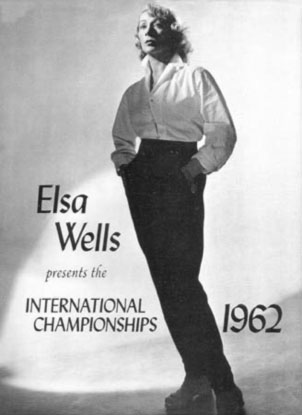Brigitt Mayer, Canada, author of Ballroom Icons©
All rights reserved. No part of this book/piece may be reproduced in any form, by print, microfilm or any other means without written permission from the author.
Find out more about Elsa Wells in Ballroom Icons
The goddess of dance – beautiful, elegant, regal, warm and generous, and a lady with immense energy; this is how her contemporaries described Elsa Wells. She “gave birth” to one of England’s largest championships which has been running since 1953, The International at London’s Royal Albert Hall. She was one of the great female coaches of her time who “felt like a second skin” when dancing with her students.

Elsa Wells was a successful amateur. Dancing with her brother John Wells, they won London’s most prestigious event of that era, the Star Championship, supported by the Star newspaper from 1925 to 1931. In 1938 the event was resumed, and the British Dancers Federation runs it today. However, it never reached its former level of prestige again.
In the early 1930s, Elsa turned professional and started dancing with James Barrel, who later changed his name to James Holland, and came second in the Star Professional Championship to Timothy Palmer and Ella Spowart.
Like all dancers of that time, Elsa and James became very innovative and created new patterns in different dances. It is said that some of the crackerjack movements in the quickstep came from them and in the tango they started the “zapateado” heel beats that they borrowed from flamenco dancing. James died young after the Second World War, and Elsa never competed again. Experts say there’s no doubt they would have continued to be highly successful competitors, but it wasn’t meant to be. Elsa started to teach and ran a studio in Bayswater, London, and then married Lavy Bakstansky.
It is said that some of the crackerjack movements in the quickstep came from them and in the tango they started the “zapateado” heel beats that they borrowed from flamenco dancing.

In 1952, Elsa had the idea of starting a new championship in London. Lavy and Lyndon Wainwright, an early Latin pioneer, became part of the organizing committee. Lavy’s connections with a Jewish fraternity proved beneficial both for the planned event, called The International, and the ballroom dancing world as a whole. The idea at that time was to collect money for Israel and hold the event together with the Jewish Observer newspaper at Royal Albert Hall on behalf of several charities.
Elsa continued to work with couples and became one of the most sought after coaches. Colleagues and critics praised her for her elegant style and students and pupils praised her for her ability to become like “a second skin” for her male pupils. The female pupils were observers and learned mostly by watching, which at the time was standard practice.
Laurie Yates, a fellow of the Imperial Society of Teachers of Dancing remembers,
“Elsa Wells was my ballroom coach when I was a junior competitor. I remember well my first lesson with her when I was 13 years old. My partner and I arrived with my parents, and while waiting in the foyer we heard this very deep woman’s voice saying to the couple she was teaching in the next room, ‘Excuse me one moment, my next victims have arrived.’ As we shook in our boots, she came out looking as she always did, like the reincarnation of Marlene Dietrich with a ‘head turning’ air of superiority, elegance and beauty.
“She was dressed, as always in a plain black silk blouse and black trousers with black leather Cuban heeled shoes, which although worn today by most ballroom women for teaching, looked very unusual at that time. She proceeded to advise us of the ‘procedure’ that we must remember when we arrived in future, which was that we should walk through the studio and sit in the armchairs on the ‘step-high’ stage, at which point she would draw the curtains.
“During lessons, the parents sat on this stage with the curtains drawn, and periodically Elsa would open them so we could demonstrate a new group or some improvement we had made. At one side of the studio she always had a small table on which stood a china teacup and saucer. Frequently during the lesson, she would take sips. We later discovered that the teacup contained gin, which probably explains why she wore such heavy perfumes. One rather nice touch she had was that she always introduced the previous couple she had taught to her next lesson by saying, ‘Do you know x & y?’ Then usually she would add, ‘I’m very pleased with them.’ The whole experience was something of an age gone by, even at that time. A bit like a scene out of a Noel Coward play or a Merchant Ivory film.”
In 1971, after Lavy’s death, Elsa appointed Albert Rudge as her organizer, and in 1976, Bobby Short, who ran it until his death in 2002. Today The International is organized by John Leach, editor of Dance News, on behalf of Dance News Special Projects Ltd. (Chairwoman Linda Short). The supported charity for the last 20 years is The British Polio Fellowship.
Brigitt Mayer, Canada, author of Ballroom Icons©
All rights reserved. No part of this book/piece may be reproduced in any form, by print, microfilm or any other means without written permission from the author.










